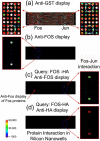High density diffusion-free nanowell arrays
- PMID: 22742968
- PMCID: PMC3412896
- DOI: 10.1021/pr300467q
High density diffusion-free nanowell arrays
Abstract
Proteomics aspires to elucidate the functions of all proteins. Protein microarrays provide an important step by enabling high-throughput studies of displayed proteins. However, many functional assays of proteins include untethered intermediates or products, which could frustrate the use of planar arrays at very high densities because of diffusion to neighboring features. The nucleic acid programmable protein array (NAPPA) is a robust in situ synthesis method for producing functional proteins just-in-time, which includes steps with diffusible intermediates. We determined that diffusion of expressed proteins led to cross-binding at neighboring spots at very high densities with reduced interspot spacing. To address this limitation, we have developed an innovative platform using photolithographically etched discrete silicon nanowells and used NAPPA as a test case. This arrested protein diffusion and cross-binding. We present confined high density protein expression and display, as well as functional protein-protein interactions, in 8000 nanowell arrays. This is the highest density of individual proteins in nanovessels demonstrated on a single slide. We further present proof of principle results on ultrahigh density protein arrays capable of up to 24000 nanowells on a single slide.
Figures






Similar articles
-
Multiplexed Nucleic Acid Programmable Protein Arrays.Theranostics. 2017 Sep 20;7(16):4057-4070. doi: 10.7150/thno.20151. eCollection 2017. Theranostics. 2017. PMID: 29109798 Free PMC article.
-
Identification of Antibody Biomarker Using High-Density Nucleic Acid Programmable Protein Array.Methods Mol Biol. 2021;2344:47-64. doi: 10.1007/978-1-0716-1562-1_4. Methods Mol Biol. 2021. PMID: 34115351
-
On-chip protein synthesis for making microarrays.Methods Mol Biol. 2006;328:1-14. doi: 10.1385/1-59745-026-X:1. Methods Mol Biol. 2006. PMID: 16785638
-
A decade of Nucleic Acid Programmable Protein Arrays (NAPPA) availability: News, actors, progress, prospects and access.J Proteomics. 2019 Apr 30;198:27-35. doi: 10.1016/j.jprot.2018.12.007. Epub 2018 Dec 12. J Proteomics. 2019. PMID: 30553075 Review.
-
In situ synthesis of protein arrays.Curr Opin Biotechnol. 2008 Feb;19(1):4-9. doi: 10.1016/j.copbio.2007.11.009. Epub 2008 Jan 18. Curr Opin Biotechnol. 2008. PMID: 18207731 Review.
Cited by
-
Microreactor array device.Sci Rep. 2015 Mar 4;5:8736. doi: 10.1038/srep08736. Sci Rep. 2015. PMID: 25736721 Free PMC article.
-
Serum profiling of the antibody response to HPV in women with or without abnormal cervical cytology undergoing cervical cancer screening.Front Immunol. 2025 Jul 31;16:1612761. doi: 10.3389/fimmu.2025.1612761. eCollection 2025. Front Immunol. 2025. PMID: 40821832 Free PMC article.
-
Novel sensor-integrated proteome on chip (SPOC) platform with thousands of folded proteins on a 1.5 sq-cm biosensor chip to enable high-throughput real-time label-free screening for kinetic analysis.bioRxiv [Preprint]. 2024 Jan 24:2024.01.23.575909. doi: 10.1101/2024.01.23.575909. bioRxiv. 2024. Update in: Commun Biol. 2025 Mar 21;8(1):468. doi: 10.1038/s42003-025-07844-z. PMID: 38328216 Free PMC article. Updated. Preprint.
-
Antiviral antibody profiling by high-density protein arrays.Proteomics. 2015 Jun;15(12):2136-45. doi: 10.1002/pmic.201400612. Epub 2015 May 15. Proteomics. 2015. PMID: 25758251 Free PMC article.
-
Micro/Nano Electrode Array Sensors: Advances in Fabrication and Emerging Applications in Bioanalysis.Front Chem. 2020 Nov 13;8:573865. doi: 10.3389/fchem.2020.573865. eCollection 2020. Front Chem. 2020. PMID: 33324609 Free PMC article. Review.
References
-
- Anderson KS, Sibani S, Wallstrom G, Qiu J, Mendoza EA, Raphael J, Hainsworth E, Montor WR, Wong J, Park JG, Lokko N, Logvinenko T, Ramachandran N, Godwin AK, Marks J, Engstrom P, Labaer J. Protein microarray signature of autoantibody biomarkers for the early detection of breast cancer. J Proteome Res. 10(1):85–96. - PMC - PubMed
-
- Jones RB, Gordus A, Krall JA, MacBeath G. A quantitative protein interaction network for the ErbB receptors using protein microarrays. Nature. 2006;439(7073):168–74. - PubMed
Publication types
MeSH terms
Substances
Grants and funding
LinkOut - more resources
Full Text Sources
Other Literature Sources

